A New Tool for Assessing Suicide Risk
Questions that save lives
After Kelly Posner Gerstenhaber ’89 worked on a major mid-2000s U.S. Food and Drug Administration study on labeling antidepressants for suicide risk, she realized she needed to address a more basic problem: Society was doing a poor job in identifying just who posed the most real and immediate risk of dying by suicide.

That realization inspired the Columbia Protocol, also called the Columbia-Suicide Severity Rating Scale (C-SSRS). It’s a plain-English questionnaire for first responders and others—especially people without any psychology training—to quickly identify who is at risk for suicide and needs intervention. The first question is, simply: “Have you ever wished you were dead or wished you could go to sleep and not wake up?”
Since winning FDA approval in 2012, the protocol has revolutionized prevention practices at a time when suicide remains the second-leading cause of death of Americans aged 10-34. It’s now used in 45 nations in six continents and has been adopted by institutions including the Pentagon, which earned Posner the Department of Defense’s medal for exceptional public service for help in curbing suicide by veterans.
“If you can’t identify the people who are suffering in silence, then you can’t save their lives,” says Posner, a professor of psychiatry and director of the Columbia Lighthouse Project, which is focused on suicide prevention.
That’s why these days Posner spends much of her time as an evangelist for the Columbia Protocol—including giving talks at FBI headquarters. She wants not only to expand its use but broaden it as a tool for breaking down mental-health stigmas and opening up conversations on other issues tied to mental health, such as gun violence. “If you can talk about suicide,” she explains, “you can talk about anything.”





